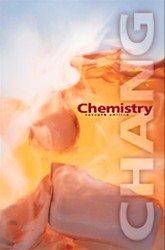 |
1 |  | 
An exothermic reaction causes the surroundings to: |
|  | A) | become basic. |
|  | B) | decrease in temperature. |
|  | C) | condense. |
|  | D) | increase in temperature. |
|  | E) | decrease in pressure. |
 |
 |
2 |  | 
How much heat is evolved when 320 g of SO2 is burned according to the chemical equation shown below?
2 SO2(g) + O2(g) ----> 2 SO3(g) DHorxn = -198 kJ |
|  | A) | 5.04 x 10-2 kJ |
|  | B) | 9.90 x 102 kJ |
|  | C) | 207 kJ |
|  | D) | 495 kJ |
|  | E) | None of the above. |
 |
 |
3 |  | 
The specific heat of aluminum is 0.214 cal/g·oC. Determine the number of calories necessary to raise the temperature of a 55.5 g piece of aluminum from 23.0 to 48.6 oC. |
|  | A) | 109 cal |
|  | B) | 273 cal |
|  | C) | 577 cal |
|  | D) | 347 cal |
|  | E) | 304 cal |
 |
 |
4 |  | 
A 60.0 g sample of an alloy was heated to 96.00 oC and then dropped into a beaker containing 87.0 g of water at a temperature of 24.10 oC. The temperature of the water rose to a final temperature of 27.63 oC. The specific heat of water is 4.184 J/g·oC. What is the specific heat capacity of the alloy? |
|  | A) | 0.313 J/g·oC |
|  | B) | 2.16 J/g·oC |
|  | C) | 0.118 J/g·oC |
|  | D) | 1.72 J/g·oC |
|  | E) | None of the above. |
 |
 |
5 |  | 
When 1.535 g of methanol (CH3OH) was burned in a constant-volume bomb calorimeter, the water temperature rose from 20.27 oC to 26.87 oC. If the mass of water surrounding the calorimeter was exactly 1000 g and the heat capacity of the bomb calorimeter was 1.75 kJ/oC, calculate the molar heat of combustion of CH3OH. The specific heat of water is 4.184 J/g·oC. |
|  | A) | -8.17 x 105 kJ/mol |
|  | B) | -817 kJ/mol |
|  | C) | 1.88 kJ/mol |
|  | D) | 817 kJ/mol |
|  | E) | None of the above. |
 |
 |
6 |  | 
To which one of the following reactions, occurring at 25 oC, does the symbol DHof [H2SO4(l)] refer? |
|  | A) | H2(g) + S(s) + 2 O2(g) ----> H2SO 4(l) |
|  | B) | H2SO4(l) ----> H2(g) + S(s) + 2 O2(g) |
|  | C) | H2(g) + S(g) + 2 O2(g) ----> H2SO4(l) |
|  | D) | H2SO4(l) ----> 2 H(g) + S(s) + 4 O(g) |
|  | E) | 2 H(g) + S(g) + 4 O(g) ----> H2SO4(l) |
 |
 |
7 |  | 
Given: SO2(g) + ½O2(g) ----> SO3(g) DHorxn = -99 kJ, what is the enthalpy change for the following reaction? 2 SO3(g) ----> O2(g) + 2 SO2(g) |
|  | A) | 99 kJ |
|  | B) | -99 kJ |
|  | C) | 49.5 kJ |
|  | D) | -198 kJ |
|  | E) | 198 kJ |
 |
 |
8 |  | 
Find the standard enthalpy of formation of ethylene, C2H4(g), given the following data: C2H4(g) + 3 O2(g) ----> 2 CO2(g) + 2 H2O(l) DHof = -1411 kJ; C(s) + O2(g) ----> CO2(g) DHof = -393.5 kJ; H2(g) + ½O2(g) ----> H2O(l) DHof = -285.8 kJ |
|  | A) | 731 kJ |
|  | B) | 2.77 x 103 kJ |
|  | C) | 1.41 x 103 kJ |
|  | D) | 87 kJ |
|  | E) | 52 kJ |
 |
 |
9 |  | 
Calculate DHorxn for the combustion reaction of CH4 shown below given the following: DHof CH4(g) = -74.8 kJ/mol; DHof CO2(g) = -393.5 kJ/mol; and DHof H2O(l) = -285.5 kJ/mol.
CH4(g) + 2 O2(g) ----> CO2(g) + 2 H2O(l) |
|  | A) | -604.2 kJ |
|  | B) | 889.7 kJ |
|  | C) | -997.7 kJ |
|  | D) | -889.7 kJ |
|  | E) | None of the above |
 |
 |
10 |  | 
A 1.300 g sample of benzoic acid (C7H6O2) was burned in a bomb calorimeter. The heat capacity of the entire apparatus, including the bomb, pail, thermometer, and water, was found to be 11,145 J/K. As a result of the reaction, the temperature of the calorimeter and water increased 4.627 K. What is the molar heat of combustion of benzoic acid? |
|  | A) | 4.84 x 106 kJ/mol |
|  | B) | -2.96 kJ/mol |
|  | C) | -4844 kJ/mol |
|  | D) | 549.1 kJ/mol |
|  | E) | 51.57 kJ/mol |
 |



 2002 McGraw-Hill Higher Education
2002 McGraw-Hill Higher Education

 2002 McGraw-Hill Higher Education
2002 McGraw-Hill Higher Education